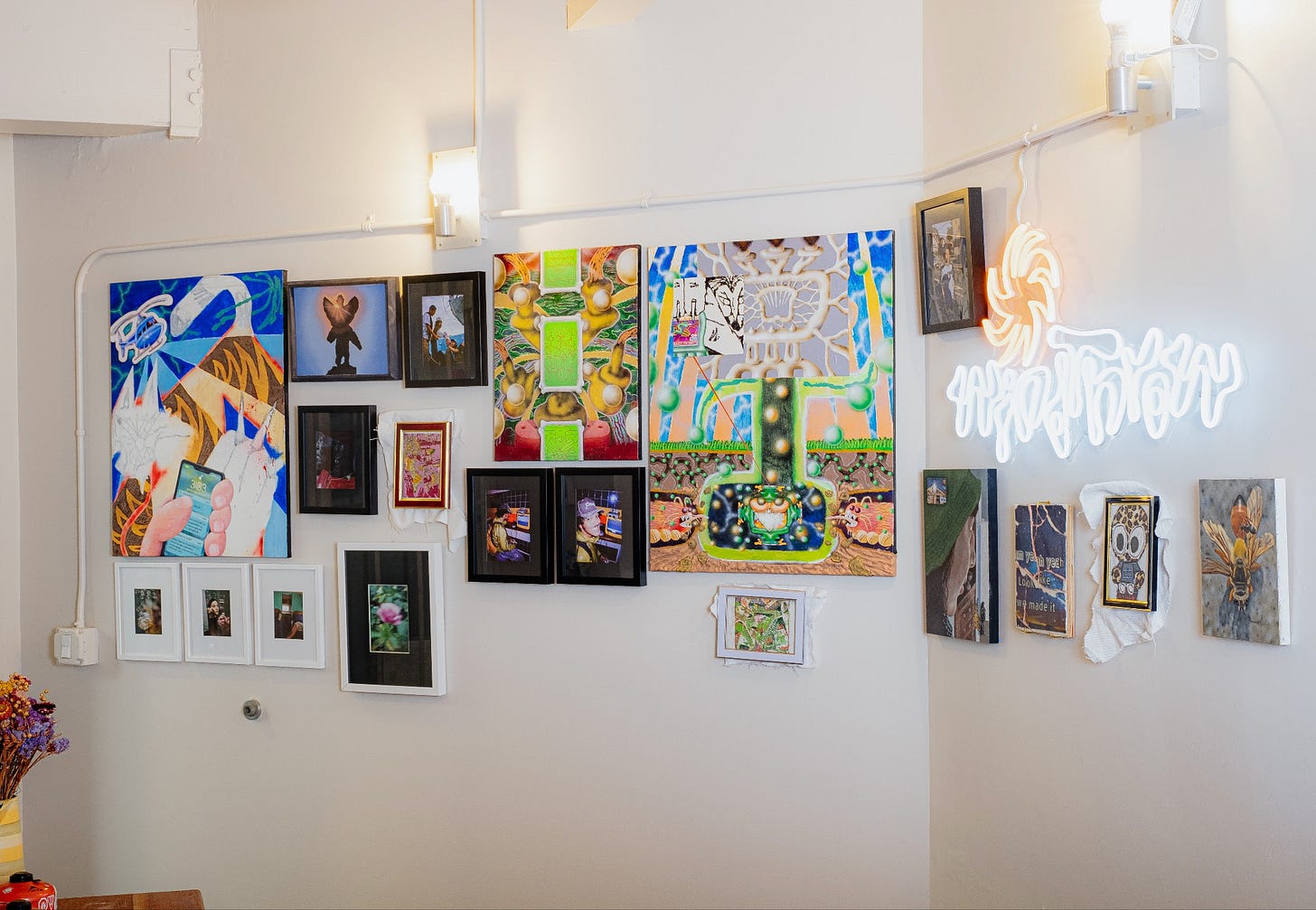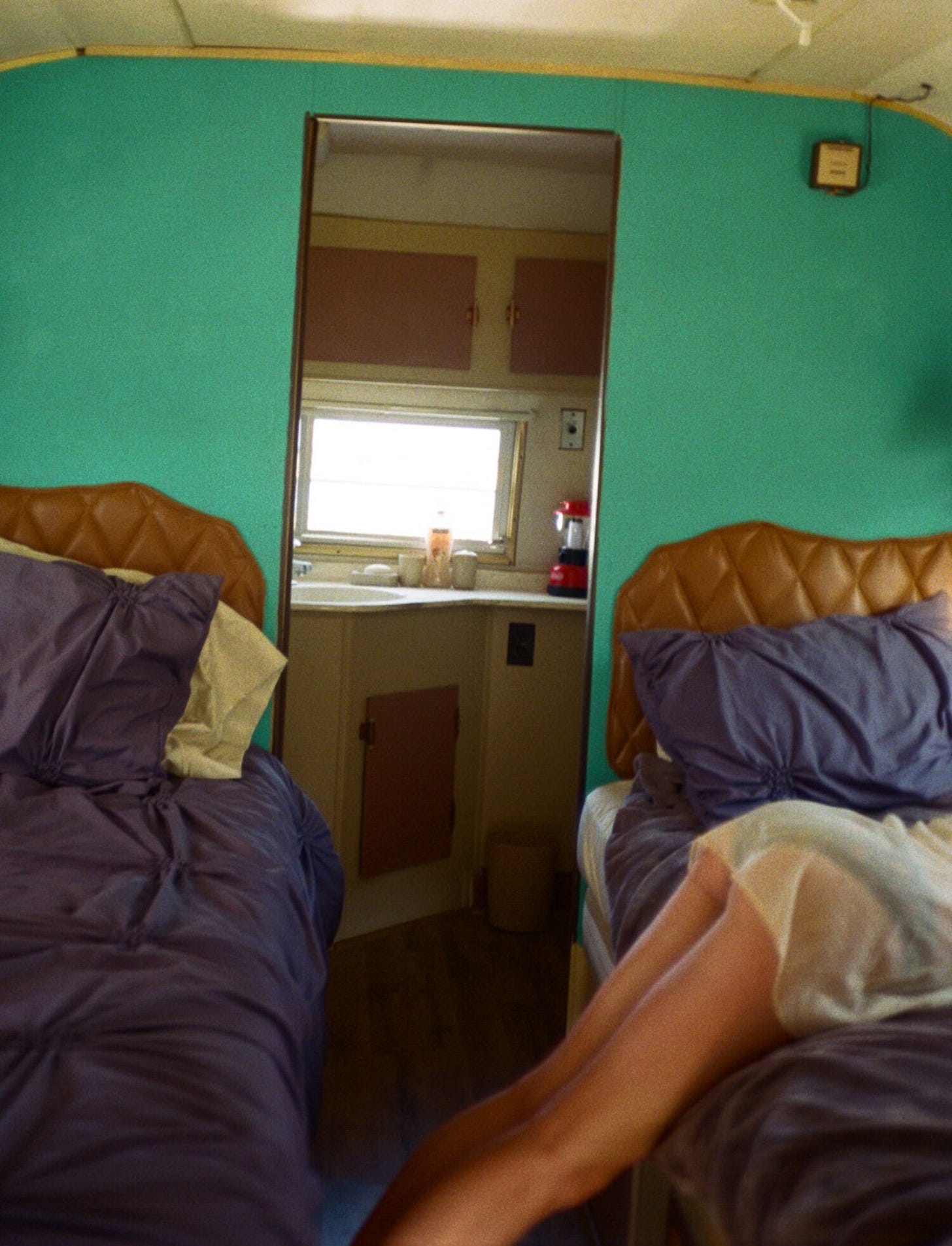In Seattle, Art and Outerwear Join Forces
In a small hallway of Seattle outerwear store Windthrow, art flourishes.
At Windthrow’s “Spent Time Outside” exhibition, curator Luca Lotruglio invited viewers to explore “the varying textures of our lives, whether they be material textures in the physical spaces we occupy or mental textures like the experiences we process and the transformations we bear. These textures, collected in unique combinations shaped by time & place, memorialize the people we’ve been when beyond familiar boundaries.”
Beyond familiar boundaries felt a fitting sentiment at the opening event on Feb. 22; meeting new people (if you live in Seattle you know this is rare), buzzing around a small store filled with exciting clothing—especially great shoes. The gallery’s size and hallway locale almost forces intimacy, quarters are simply too tight not to hear the person inches away from you mumble “Oh I like this one,” gesturing towards Jordan Lewis’s portrait of a friend getting ready for a night out in a mirror. Or, “This one’s actually held together by gum,” Lotruglio says gesturing towards Mikaela Kautzky’s piece. Or, if you were standing next to me, “Oh my god is that Darrian?” I say, looking up at a portrait of my coworker, a member of local skate team Genesis.
It’s not unlike the nature of this city to find yourself in an outerwear store on a Friday night, however a gallery curated with a wide range of artists and mediums, from Oakland-based Quinn Girard’s detailed, vibrant, textural imagery of Roundup weed killer to Seattle and Los Angeles-based photographer Tim Hogan’s documentation of the early days of Genesis—unique.
Windthrow’s owner, Nate Hoe, is to thank for this space’s multifunctionality and sense of community.
With Windthrow, established in April 2023, Nate “wanted to not only showcase all the local scenery and talent and creative energy that Seattle has, itself, but also just create this vibe of a group of friends having fun all the time,” Hoe said.
Experienced in throwing underground parties, from Mario Kart tournaments to indoor stationary bike races, hosting an art gallery felt natural.
Windthrow, afterall, displays its merchandise in a curated, gallery-like setting, with a tent suspended upside down from the ceiling, Italian-made angular biking sunglasses displayed on a slab of stone, and a collection of artfully practical shoes, from Nordarun’s sleek Canadian sneakers to Merrell’s croc-like “Hydro Moc” slides, amongst hyper-practical tent stakes or carabiners; anything needed for spending time outside.
Like the rock display or the tactical gear suspended from the ceiling, “Spent Time Outside” takes on a textural focus, displayed in the artists’ range of materials, methodology, and style, while simultaneously focusing on the artist and viewer on a human level; the experiences we encounter that, much like the experience of visiting the gallery itself, transform mental texture through community and connection. Spending time outside doesn’t have to be literal, you don’t need to go climb a rock, although many people in Seattle do, but also being outside of familiar boundaries, and challenging views of what an art gallery can or should be.
For the seven artists featured in the show—Gbuck, Quinn Girard, George Goldberg, Tim Hogan, Mikaela Kautzky, Jordan Lewis, and Lily Jane Rand—mental textures and memory correspond directly to the textures used in their art.
Quinn Girard’s paintings are immediately captivating, with their large scale, vibrant color palette, and mix of imagery ranging from retro video games, vampires and surreal media landscapes; his piece “Tiger Attaq” documents a tiger escape from the Oakland Zoo. Girard’s art is the clear work of a lifelong artist, who overtime has drawn inspiration from children’s book illustrations, graffiti, video games, renaissance paintings, pictographs, funk art, abstract expressionism and Ikea building manuals.
“I want to make objects that have a certain tactility and feel visually, and texture for me functions on a very immediate and sublingual level,” Girard said. “We respond emotionally and almost pre-cognitively to ‘sharp’ ‘soft’ ‘rough’ and ‘smooth’ before registering almost anything else about an object.”
Quinn’s interpretation of the outdoors stands alone in the gallery, specifically in his piece titled “Roundup Daemon.”
“The top left corner of ‘Roundup Daemon’ depicts a vampire loosely based off ‘The Count’ from Sesame Street holding up a bag of Monsanto seeds,” Girard said. “This is diagrammatically linked to a five dimensional bottle of Roundup incarnating as a demon at the base of the crop. I like to use vampires as a symbol of greed and extraction, non reciprocally siphoning life force and energy.”
When painting, Girard relies on the memory of texture to form imagery, not using a reference in most of his work. For example, with sand he “will think of sand texturally and physically, and just paint a million different colored spots on top of each other until it feels like sand [or] replicates what sand is,” Girard said. He also adds elements like sand to the paint to “break down the boundary between the painting and what it is portraying.”
When beginning to consider texture as a theme for the show, Lotruglio first gravitated towards Canadian artist Mikaela Kautzky for texture-heavy art, specifically a piece titled “Looks like We Made It.”
Kautzky’s texture-heavy ceramic piece, made from broken ceramic tile glazed with a screenshot of the karaoke video from “You’re Still the One” by Shania Twain, with the pieces held together by chewed bubblegum.
While making up with their partner after a falling out, Kautzky felt “there was still love and good times between us and we could still find joy together in drinking a beer and listening to Shania,” Kautzky said. “I think [gum] is a nice material to bring in feelings of kissing and romantic touchy love.”
Utilizing memory to actualize physical texture is intrinsically connected to the work of local photographers Tim Hogan, Jordan Lewis and George Goldberg, who’s photos, ranging from portraiture to street photography, capture intimate moments in time. These captured moments are narratives of connectedness, memory, and even nostalgia, consisting of cross-country road trips, a friend group (doubling as a prolific Seattle skate team)’s first trip to New York, and a portrait of a neighbor.
Although recently relocated to Los Angeles, many of Hogan’s photos—taken on a Fujifilm digital pocket camera—were taken in Seattle of local skate team Genesis, or Tacoma-based indie rock band Enumclaw. A distinctly memorable photo comes to mind of the Genesis team at Flushing park during their first trip to New York, one of the first photos Hogan took.
“That permanence of just getting that photo, and it can last forever if it's preserved right, that was always my real inspiration in terms of getting into photography,” Hogan said. “It's like future nostalgia…Most of it is memory based, or trips and experiences with friends…that's what matters most, I was there, in the moment, I felt that that mattered enough to take a photo of it.”
After immersing himself in photography further, specifically Dawoud Bey’s portraiture approach in familiarizing himself with his subjects before taking a photo, Hogan aimed to develop a similar methodology not in technique but method.
Hogan valued Bey’s prioritization of “meeting these people, community members in their community and developing relationships with them to get to the point where they can shoot the photo…I want to let [my photography subjects] know that I think what you're doing matters, or that you matter.”
George Goldberg’s portrait of his neighbor, Julio, on his porch is a testament to this ethos.
Goldberg had mentioned to Lotruglio that “he'd always go over and talk to Julio, Julio would be drinking his non-alcoholic beers, and they would just talk about life,” Lotruglio said. “And what I think is really incredible about that photo is, it's just a photo of the person…but based on the color of the light that's pouring in on them, you can tell that they're outside.”
Jordan Lewis’s trio, a series of film photographs taken over the course of four years, were united for the show with Lotruglio’s help, who combed through Lewis’s portfolio to select images.
“[The trio] kind of was getting ready the night out, the morning after. And that was that was the time spent outside, was kind of more…the feeling of being out,” Lewis said. “The anticipation is the more frantic, double-exposed photo of my friend getting ready, and then in the middle is kind of this like blurry florals…and then [this] relaxed kind of like atmosphere afterwards with another friend just like lying over the sofa, and you're in a trailer but you don't know where or when.”
Goldberg and Lewis’s work extend to Windthrow’s stylish editorial and product photography, with many shoots inspired by outerwear ads from the late 1970’s and 80’s—the vision was propelled by store owner Nate Hoe, who comes from a family of outdoor endurance athletes with a love for European outerwear; Norrøna, for example.
“It's not only really interesting from a technical perspective in terms of photography and what [70’s/80’s advertisements] were able to accomplish,” Hoe said, “but also in terms of the attitude, it's very rebellious and fun and, and just kind of countercultural in a way.”
Although perhaps considered mainstream in an outdoor-focused city like Seattle, outerwear aesthetics, if portrayed through a local, less commercialized lens, embody this countercultural spirit. Lewis is critically aware of this fact, with an innate eye for editorial imagery and years of styling experience, Lewis’s editorial shoots for Windthrow are vibrant but maintain a vintage feel, photographing a local musician Jagua in Windthrow outerwear. At Windthrow outerwear is for stylish musicians, too.
It seems this is what unifies the gallery’s amalgamation of artists, from Seattle and beyond, in the first place. When determining the show’s range of artists, Luca considered their corresponding audiences.
“Tim Hogan (Genesis filmer) drew a skater crowd, Mikaela Kautzky (Seen Snowboarding) drew a snowboard crowd, GBUCK drew a graffiti crowd, George and Jordan drew a Seattle crowd, Windthrow drew a Seattle/outdoor sports crowd, Lily drew a New York (virtual) crowd,” Luca said.
Windthrow doesn’t subscribe to just one thing, although they sell high-performing, stylish outerwear and essential sporting equipment—Hoe mentioned some swing by the store to browse quality fleeces, others make a pit stop in need of tent stakes—it’s a multifunctional community space. Hoe, himself, doesn’t subscribe to one aesthetic either, passionate about high-performance athletic gear while writing his Parsons thesis on the countercultural nature of renaissance fair dressing. The space is truly and uniquely open to passionate people of all interests.
“It's hard when you put yourself on Google, you have to list one category and so it's an outdoors equipment store,” Hoe said. “Ideally it feels as much like a skate shop as it is an outdoor store as it does a gallery space.”
So, what to do with so many people passionate about their interests but with minimal outlets of expression in a notorious tech city? It feels redundant to say that Seattle doesn’t have an overwhelm of art-related activities for your Friday night. Nate, however, may disagree. With his small company of two, Seattle Department of Design, Hoe seeks to refresh and revitalize Seattle’s visual language, creating and selling Seattle Parks and Recreation merch in collaboration with Nordstrom, and most recently hosting a panel at the “First Thursdays” Art Walk in Pioneer Square.
“That First Thursday's concept has actually been exported to a bunch of other American cities, including Chicago, New York, LA,” Hoe said. “But it started here, and it was this really novel concept at the time of galleries coming together to cooperate and share a customer base, which was unheard of for competitors to do. To create an environment where people could shop art, but also meet each other and interface with artists and, just get drunk and, and enjoy culture.”
Art can and has been accessible here, and Windthrow is going to greater lengths to make that possible. The exhibition wrapped late March, but it’s impact feels lasting, hopeful.








